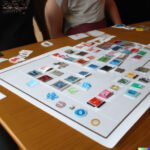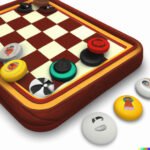Checkers has long held its place as one of the most beloved and enduring classic board games. With a rich history and widespread popularity, Checkers continues to captivate players of all ages around the world.
In this article, we will take a closer look at the game of Checkers, exploring its origins, rules, strategies, variations, and its impact in various aspects of life. Whether you’re a seasoned player or new to the game, this comprehensive guide will provide you with everything you need to know about Checkers.
Dating back thousands of years, Checkers has evolved from ancient Egyptian ancestors to become a favorite pastime in many cultures. Known for its accessibility and straightforward gameplay mechanics, Checkers has stood the test of time. Players aim to capture their opponent’s pieces by strategically maneuvering their own across the checkered board. We’ll delve into the rules and intricacies of this classic contest that has intrigued minds for generations.
As we embark on this exploration into the world of Checkers, we’ll not only cover the fundamentals but also dive deeper into advanced strategies used by seasoned players. From mastering opening moves to executing double jumps and sacrificing pieces for strategic gains – we’ll uncover tips and tricks that are sure to improve your skills. Additionally, we’ll introduce you to popular variations of Checkers beyond the traditional game, offering a fresh perspective for those seeking heightened challenges.
So join us as we celebrate Checkers as an enduring classic board game that transcends boundaries and brings joy to people across all walks of life. Whether you’re aiming to sharpen your skills or simply looking for an engaging pastime with family and friends, this article is your ultimate resource for all things related to Checkers – from history and strategy to educational benefits and cultural influence.
Get ready to rediscover the timeless allure of Checkers in ways you’ve never imagined.
Understanding the Basic Rules of Checkers
Checkers is a classic board game that has captivated players for centuries. It is a two-player game played on an 8×8 checkered board, and it has simple yet strategic gameplay mechanics that keep players engaged. In this section, we will delve into the basic rules of Checkers, including how to set up the board, movement and capturing rules for both black and white pieces, and the significance of achieving a “kinged” piece.
To start playing Checkers, each player begins with 12 pieces placed on the dark squares of their respective sides of the board. The goal is to capture all of your opponent’s pieces or block them so they are unable to move. The first player to accomplish this wins the game.
Moving your pieces in Checkers follows a specific set of rules. Each piece can only move diagonally forward one space. However, if there is an opposing piece adjacent to yours and there is a vacant space on the other side of it, you have the option to capture that piece by jumping over it diagonally and landing in the empty space immediately beyond it. You can make consecutive jumps as long as there are opportunities for captures.
One important rule in Checkers is that regular pieces can only move forward until they reach the last row on their opponent’s side. Once a regular piece reaches this row, it becomes “kinged.” A kinged piece gains additional movement abilities and can move forward or backward diagonally any number of spaces during its turn. This makes kinged pieces more powerful and versatile in capturing opponents’ pieces.
Strategy Tips and Tricks for Checkers
Setting the Foundation: Essential Strategies for Beginners
For beginners looking to improve their Checkers game, it is crucial to familiarize themselves with some essential strategies. One of the most important concepts in Checkers is controlling the center of the board. By occupying and advancing pieces towards the center squares, players gain more flexibility and options for future moves. Players should plan their initial moves with this strategy in mind, focusing on maintaining a strong presence in the middle of the board.
Another key strategy is maintaining a balance between offense and defense. It can be tempting to focus solely on capturing opponents’ pieces, but neglecting defensive moves can leave one vulnerable to counterattacks. Finding the right balance involves protecting your own pieces while simultaneously putting pressure on your opponent’s pieces.
Additionally, beginners should pay close attention to piece positioning. Keeping pieces grouped together allows for better coordination and stronger defensive formations. This formation also provides opportunities for double jumps, as it sets up potential captures if an opponent’s piece lands adjacent to a clustered group.
Mastering Opening Moves: Advantageous Strategies from the Start
The opening moves in Checkers set the tone for the entire game, so it’s essential to understand some advantageous strategies when starting a match. The most common opening move is known as “11-15” or “9-14,” referring to moving one of the back rank pawns up two spaces diagonally towards the center of the board. This move establishes control over multiple central squares and clears a path for future advancements.
Another effective opening move is called “8-12.” This involves moving one of the central pawns forward three spaces diagonally towards your opponent’s side of the board. This move puts early pressure on your opponent’s formation and forces them to make defensive moves right from the start.
Lastly, beginner players can experiment with different variations of “openings,” which refer to specific sequences of moves at the beginning of the game. Each opening has its own advantages and disadvantages, providing players with diverse strategies to choose from based on their playing style and personal preferences.
Advanced Tactics: Double Jumps, Sacrifices, and Forks
As players progress in skill level, they can employ more advanced tactics to outwit their opponents. One such tactic is known as a double jump or multiple capture. This occurs when a player’s piece performs consecutive captures in one turn by jumping over multiple opponent pieces diagonally. Capitalizing on double jumps not only allows for significant piece advantage but also disrupts your opponent’s formation.
Sacrificing pieces strategically is another advanced technique used to gain a tactical advantage. By intentionally sacrificing one of your pieces to lure an opposing piece into a vulnerable position, you create opportunities for multiple subsequent captures and positional advancements.
Lastly, forks are crucial tactical maneuvers that involve threatening two or more of your opponent’s pieces simultaneously. By creating this type of dilemma for your opponent, they are forced to sacrifice one piece for the safety of the other, granting you an advantageous position on the board.
By familiarizing themselves with these essential strategies and advanced tactics, Checkers players can enhance their gameplay and improve their chances of success on the board. As with any skill-based activity, practice becomes imperative in implementing these strategies effectively over time.
Popular Checkers Variations
Checkers, also known as Draughts in some countries, has a rich history and has been enjoyed by countless players around the world for centuries. While the classic game of Checkers is well-known and loved, there are several variations that add exciting twists to the traditional gameplay. In this section, we will explore some popular Checkers variations that offer unique challenges and strategic opportunities.
International Draughts
One of the most widely played variations of Checkers is International Draughts, which follows a set of rules recognized by international organizations. This version is played on a larger 10×10 board with each player starting with 20 pieces instead of 12. The main difference lies in the enhanced capturing mechanics.
Unlike in the classic game where you can only capture forward diagonally, in International Draughts, you have the option to move backward and capture both forward and backward diagonally. This rule opens up new tactics and strategic possibilities that require careful planning and calculation.
Brazilian Checkers
Brazilian Checkers, or Brazilian Draughts, is another variation that originated from Brazil and gained popularity in South America. Played on an 8×8 board like the classic game but with additional rules for promotion and capturing mechanisms.
Similar to its international counterpart, Brazilian Checkers allows backward movement and capturing but also incorporates flying kings-pieces that can move long distances diagonally across the board while capturing multiple opponents in one turn. This adds more complexity to the game as players must consider long-range moves and jumps while aiming to crown their pieces.
Turkish Checkers (Dama)
Turkish Checkers, known as Dama in Turkey, has its own distinct set of rules that differ from both classic checkers and international draughts. This variation is played on an 8×8 board, with each player having 16 pieces. The unique rule in Turkish Checkers is that pieces can only move diagonally forward but can capture both forward and backward.
Additionally, when a piece reaches the last row, it promotes to a king that moves one step diagonally but has the ability to move freely across the board without limitations. The tactical dynamics of Turkish Checkers make for an engaging and challenging gameplay experience.
These are just a few examples of the many intriguing variations of Checkers that exist beyond the classic game. Each variation offers its own set of rules and strategic nuances, allowing players to explore different approaches and tactics. Whether you’re a seasoned player looking for new challenges or a beginner eager to expand your Checkers knowledge, these variations provide fresh excitement while still capturing the essence of this timeless classic board game.
The Checkers Community
Checkers is not just a game to be played casually among friends and family; it also has a thriving competitive scene. The Checkers community offers a range of opportunities for players to engage in tournaments, connect with other enthusiasts, and play the game online.
For those looking to test their skills on a competitive level, participating in local and international Checkers tournaments can be an exciting experience. These tournaments bring together skilled players from various backgrounds to compete for recognition and prizes. Whether you are a beginner or a seasoned player, tournaments provide an excellent platform to showcase your abilities and learn from others.
In the digital age, many Checkers enthusiasts turn to online platforms to play against human opponents from around the world. These platforms offer the convenience of playing anytime and anywhere without the need for physical boards or pieces. Some popular online platforms for playing Checkers include Board Game Arena, Pogo, and FlyOrDie. These platforms often provide different modes of gameplay, including options for beginners or more experienced players.
Joining local Checkers clubs is another great way to immerse yourself in the Checkers community. These clubs offer regular meetups where enthusiasts can come together to play friendly games, learn new strategies, and foster connections with like-minded individuals. Clubs often host their own tournaments or organize events where players can further hone their skills in a supportive environment.
In summary, the Checkers community provides avenues for both competitive play and casual enjoyment of the game. From participating in tournaments to playing online against opponents from around the world or joining local clubs, there are numerous ways for enthusiasts to engage with fellow players. Whether you are seeking recognition as a top player or simply want to connect with others who share your passion for Checkers, exploring these aspects of the community can be a rewarding experience.
| Tournaments | Online Platforms | Clubs |
|---|---|---|
| Opportunities to compete on a competitive level | Convenience of playing anytime, anywhere | Regular meetups to play friendly games and learn new strategies |
| Brings together skilled players from various backgrounds | Popular online platforms include Board Game Arena, Pogo, and FlyOrDie | Foster connections with like-minded individuals |
| Showcases abilities and provides learning opportunities | Different modes of gameplay for beginners or experienced players | Host their own tournaments or organize events for skill development |
Checkers as an Educational Tool
Playing Checkers goes beyond just entertainment; it also provides numerous benefits for children’s educational development. This section will discuss the advantages of playing Checkers for children, including strategic thinking, logical reasoning, focus, patience, and decision-making skills.
One of the primary educational advantages of playing Checkers is its ability to enhance strategic thinking and logical reasoning in children. The game requires players to analyze the board, anticipate their opponent’s moves, and plan their own moves accordingly. By engaging in this strategic thinking process, children develop problem-solving skills and learn to think critically.
Furthermore, playing Checkers helps improve focus and concentration in children. To successfully play the game, they need to pay close attention to the board and their opponent’s movements. This promotes focus and trains them to avoid distractions while making decisions.
The game also teaches patience as children must wait for their turn and carefully assess each move before making a decision. Patience is an essential life skill that can be fostered through activities like playing Checkers.
Lastly, playing Checkers enhances children’s decision-making skills. They learn to weigh different possibilities, evaluate risks and rewards, and make calculated choices based on the current board state. These decision-making abilities transfer well into real-life situations where they have to make choices with consequences.
To leverage this educational potential of Checkers further, various resources are available that utilize the game for learning purposes. Online platforms offer interactive tutorials that teach children strategies and techniques step by step. There are also printable worksheets or activity books featuring Checkers puzzles designed specifically to promote critical thinking skills in children.
By incorporating Checkers into their educational routine or extra-curricular activities, parents and educators can help stimulate young minds while fostering important cognitive capabilities necessary for success later in life.
Checkers in Pop Culture
Checkers, as a classic board game, has not only captured the hearts of players around the world but has also made its mark in various forms of pop culture. From literature to movies to art, Checkers has found its place as a symbol of strategy, competition, and entertainment.
In literature, Checkers has often been used as a metaphor for strategic thinking and decision-making. One notable book that showcases the game is “Through the Looking-Glass” by Lewis Carroll. The famous scene featuring Alice playing a game of chess with living pieces includes a reference to Checkers as a simpler alternative that she considers playing. This reference serves to highlight the intellectual aspects of both games and the importance of strategic planning.
In the world of cinema, there have been movies that revolve around or feature scenes with Checkers gameplay. For example, “The Lavender Hill Mob” (1951) is a British comedy film where two characters play Checkers while discussing their grand plan for a heist. The game adds an element of suspense and anticipation to the scene, emphasizing the strategic nature of their scheme.
Moreover, in art, Checkers has served as inspiration for various renowned artists throughout history. Piet Mondrian’s painting “Checkerboard Composition with Gray,” created in 1919-1920, demonstrates his fascination with geometry and abstraction through the use of checkered patterns. Other artists like Alexander Calder have also incorporated checkered elements into their works, adding visual interest and symbolism.
| Pop Culture Reference | Year | Description |
|---|---|---|
| “Through the Looking-Glass” by Lewis Carroll | 1871 | Alice considers playing Checkers as an alternative to chess, highlighting strategic thinking. |
| “The Lavender Hill Mob” | 1951 | A comedy film featuring a scene where characters play Checkers while discussing their heist plan. |
| Piet Mondrian’s “Checkerboard Composition with Gray” | 1919-1920 | A painting showcasing the artist’s fascination with geometry and abstraction through checkered patterns. |
These instances are just a glimpse of how Checkers has permeated popular culture. Whether as a symbol of intellectual prowess, a plot device, or an artistic inspiration, Checkers continues to contribute to the creative landscape. The game’s timeless appeal creates a connection between players and enthusiasts in various artistic forms, further cementing its status as a classic board game that transcends time.
If you’re interested in exploring further into the intersection of Checkers and pop culture, there are numerous books and movies worth delving into. Additionally, keep an eye out for galleries or exhibitions that feature artworks incorporating Checkers themes. By immersing oneself in these cultural references, one can appreciate the significance of Checkers beyond its gameplay and embrace it as a symbol of creativity and imagination.
Rediscovering Checkers
Checkers is more than just a game; it holds nostalgic memories for many individuals who have fondly played it during their childhood. Rediscovering Checkers as adults can bring back a sense of nostalgia and allow us to relive those cherished moments. With the rise of digital gaming, traditional board games like Checkers often get overlooked. However, there is something special about sitting down with loved ones and playing a physical game, reviving old memories and creating new ones.
In this modern age, where technology dominates our leisure time, taking the time to go back to classic board games like Checkers can be a refreshing change of pace. Playing Checkers provides an opportunity for face-to-face interaction, encouraging social bonding and strengthening relationships with friends and family members.
In a world filled with screens and virtual connections, sitting around a table and engaging in a friendly competition can create lasting memories that cannot be replicated in the digital realm.
One way to incorporate Checkers into your life is by organizing family gatherings or game nights centered around this timeless classic. Dust off that old board, gather your loved ones, and enjoy an evening of fun and laughter as you rediscover the joy of playing Checkers together. Whether it’s competing for championship titles or simply enjoying each other’s company over a friendly game, these moments will become treasured memories that you can look back on with warmth.
So why wait? Embrace the nostalgia and bring Checkers back into your life. Rediscover the joy of strategizing moves, capturing opponents’ pieces, and achieving victory one jump at a time. Let this simple yet captivating game transport you back in time while creating new memories that will last a lifetime.
Conclusion
In conclusion, Checkers truly stands as a timeless classic board game that has captivated players for centuries. Its simple rules and addictive gameplay have made it a staple in households worldwide. Through understanding and mastering the basic rules of Checkers, players can engage in strategic battles that challenge their critical thinking skills and decision-making abilities.
Furthermore, the Checkers community offers various opportunities for players to connect with like-minded enthusiasts from around the world. From local tournaments to online platforms, there are endless avenues to compete and improve one’s skills. Joining a Checkers club or participating in tournaments not only boosts one’s competitive spirit but also fosters a sense of camaraderie among players who share the same passion for the game.
Moreover, Checkers extends beyond its status as a mere form of entertainment; it serves as an educational tool for children as well. Playing Checkers helps children develop crucial skills such as strategic thinking, logical reasoning, focus, patience, and decision-making abilities. With numerous educational resources available that utilize Checkers for learning purposes, parents and educators can harness these benefits and provide an engaging yet beneficial learning experience.
Frequently Asked Questions
How do you play classic checkers?
Classic checkers is a two-player board game that is played on an 8×8 checkered board. Each player begins with 12 checker pieces, usually in contrasting colors such as black and red. The goal of the game is to either capture all of the opponent’s pieces or block them so they cannot make any more moves.
Players take turns moving their pieces diagonally forward, one space at a time unless they are capturing an opponent’s piece. When a player’s piece reaches the last row on the opponent’s side, it is crowned and becomes a “king,” allowing it to move both forward and backward on subsequent turns. The game continues until one player achieves their objective or both players agree to a draw.
What is the oldest game of checkers?
The oldest game of checkers traces its roots back several millennia. Known as Alquerque, it is believed to have originated in ancient Mesopotamia or Egypt around 1400 BCE. Alquerque used a 5×5 board marked with intersecting lines, similar to traditional checkers but on a smaller scale.
It was played by two opponents who took turns moving their five pieces along the lines and attempted to capture each other’s pieces by jumping over them in diagonal movements akin to modern-day checkers. Although variations of this ancient game can be found across different civilizations and cultures throughout history, Alquerque continues to hold the title for being the earliest known precursor to modern checkers.
How many different checkers games are possible?
While the number of possible specific games of checkers is difficult to determine precisely due to various factors such as initial configuration and players’ strategies, there are around 5 x 10^20 (5 followed by twenty zeros) legal positions that can arise during a game of standard checkers without crowning any kings. This astronomical figure showcases just how immense the potential gameplay possibilities are in checkers.
With every move made by each player, countless branching paths open up, creating an incredibly complex decision tree. Additionally, when considering the additional complexity brought about by crowning pieces, it becomes abundantly clear that the total number of distinct checkers games is incalculable.

I love playing all kinds of games – from classics like Monopoly to modern favourites like Ticket to Ride.
I created this blog as a way to share my love of board games with others, and provide information on the latest releases and news in the industry.





